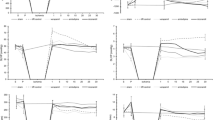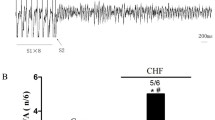Abstract
Recent evidence suggests that newer vasoselective dihydropyridine calcium antagonists are not cardiodepressant and may be useful in the treatment of heart failure. No data are available on the efficacy of clentiazem, a vasoselective benzothiazepine-like calcium antagonist, in this pathological condition. Therefore, our objective was to assess coronary and cardiac sensitivity to clentiazem in an experimental model of chronic heart failure (cardiomyopathic hamster, UM-X7.1, >200 day old). Left ventricular developed pressure (LVP) and coronary flow changes were assessed in isolated, perfused failing hearts and in normal Syrian hamster hearts. Clentiazem dose-response curves for both coronary dilation and negative inotropic effects were determined under control conditions and in the presence of the nitric oxide (NO) synthase inhibitor, NG-nitro-L-arginine (L-NAME, 30 μM), and the cyclooxygenase inhibitor, indomethacin (10 μM). Baseline hemodynamics indicate a significant reduction in both LVP and coronary perfusion in failing hearts. Cardiac sensitivity to the negative inotropic effects of clentiazem were similar in normal and failing hearts (IC50 = 677 nM and 734 nM, respectively). However, the clentiazem-induced increase in coronary flow was significantly attenuated in failing hearts (EC50 = 56 ± 9 nM vs. 15 ± 3 nM in normal hearts, p < 0.01). To better characterize the reduced coronary sensitivity to clentiazem in the presence of heart failure, the contributions of the NO synthase and the cyclooxygenase pathways were evaluated. Although coronary sensitivity to clentiazem was significantly reduced in the presence of L-NAME, this attenuation was of the same magnitude in normal and failing hearts, suggesting that coronary desensitization to clentiazem in failing hearts does not involve the NO synthase pathway. Experiments carried in the presence of indomethacin indicate that the reduced coronary sensitivity to clentiazem observed in failing hearts does not involve the cyclooxygenase pathway. In conclusion, reduced coronary sensitivity to the vasoselective calcium antagonist clentiazem was observed in the failing hamster heart, while no exacerbation of clentiazem's cardiodepressant actions was present. Although the mechanisms involved in the vascular desensitization to clentiazem are still unknown, our findings may provide an additional explanation for the variable efficacy of calcium antagonists in the treatment of heart failure.
Similar content being viewed by others
References
Packer M. Pathophysiological mechanisms underlying the adverse effects of calcium channel-blocking drugs in patients with chronic heart failure. Circulation 1989;80(Suppl IV):59-67.
Parameshwar J, Poole-Wilson PA. The role of calcium antagonists in the treatment of chronic heart failure. Eur Heart J 1993;14(Suppl A):38-44.
Reicher-Reiss H, Barasch E. Calcium antagonists in patients with heart failure. Drugs 1990;42:343-364.
de Vries RJM, Dunselman, PHJM. The potential role of calcium antagonists in the management of congestive heart failure: Initial experience with lacidipine. J Cardiovasc Pharmacol 1995;25(Suppl 3):S33-S39.
Little WC, Cheng C-P, Elvelin L, Nordlander M. Vascular selective calcium entry blockers in the treatment of cardiovascular disorders: Focus on felodipine. Cardiovasc Drugs Ther 1995;9:657-663.
Packer M. Calcium antagonists for congestive heart failure: Evolving concepts in bridge building. Cardiovasc Drugs Ther 1993;7:95-96.
Véniant M, Clozel JP, Hess P, Wolfgang R. Ro 40-5967, in contrast to diltiazem, does not reduce left ventricular contractility in rats with chronic myocardial infarction. J Cardiovasc Pharmacol 1991;17:277-284.
Clozel JP, Véniant M, Osterrieder W. The structurally novel Ca2+ channel blocker Ro 40-5967, which binds to the 3H desmethoxyverapamil receptor, is devoid of the negative inotropic effects of verapamil in normal and failing hearts. Cardiovasc Drugs Ther 1996;4:731-736.
Narita H, Ginsburg R. In-vitro study of the effect of clentiazem on rabbit aorta and on myocardiom. Cardiovasc Drugs Ther 1990;4:723-730.
Dumont L, Derouin M, Chartrand C, Archambeault P, Garceau D, Caillé G. Peripheral vasodilator and cardiac properties of the 1,5-benzothiazepine calcium antagonist analog, TA-3090, in dogs. Can J Physiol Pharmacol 1991;69:512-517.
Grover GJ, Sleph PG. Dissociation of cardiodepression from cardioprotection with calcium antagonists: Diltiazem protects ischemic rat myocardium with a lower functional cost as compared with verapamil or nifedipine. J Cardiovasc Pharmacol 1989;14:331-340.
Tanguay M, Lepage G, Blaise G, Garceau D, Dumont L. Clentiazem, diltiazem, and cold cardioplegia in isolated ischemic rabbit hearts: Relation between additive cardioprotection, physicochemical properties, and preservation of myocardial lipid components. J Cardiovasc Pharmacol 1994;24:950-959.
Bourassa MG, Côté P, Théroux P, Tubeau JF, Genain C, Waters DD. Hemodynamics and coronary flow following diltiazem administration in anesthetized dogs and in humans. Chest 1980;78(Suppl 1):224-230.
Murata K, Kikkawa K, Yabana H, Nagao T. Cardiovascular effects of a new 1,5-benzothiazepine calcium antagonist in anesthetized dogs. Drug Res 1988;38:521-525.
Narita H, Zera PH, Ginsburg R. Mechanism of action of clentiazem on human coronary artery and myocardium. Cardiovasc Drugs Ther 1990;4:1097-1104.
Inoue T, Sakai Y, Morooka S, et al. Vasodilatory capacity of coronary resistance vessels in dilated cardiomyopathy. Am Heart J 1994;127:376-381.
Unverferth DV, Magorien RD, Lewis RP, Leier CV. The role of subendocardial ischemia in perpetuating myocardial failure in patients with nonischemic congestive heart failure. Am J Cardiol 1983;105:176-179.
Vatner SF. Reduced subendocardial myocardial perfusion as one mechanism for congestive heart failure. Am J Cardiol 1988;62:94E-98E.
Weiss MB, Ellis K, Sciacca RR, Johnson LL, Schmidt DT, Cannon PJ. Myocardial blood flow in congestive and hypertrophic cardiomyopathy. Circulation 1976;54:484-494.
Katz SD, Schwarz M, Yuen J, LeJemtel TH. Impaired acetylcholine-mediated vasodilation in patients with congestive heart failure. Role of endothelium-derived vasodilating and vasoconstricting factors. Circulation 1993;88:55-61.
Lüscher TF, Noll G. Endothelium-dependent vasomotion in aging, hypertension, and heart failure. Circulation 1993;87(Suppl VII):97-103.
Jayakody RL, Kappagoda CT, Senaratne MPJ, Sreeharan N. Absence of effect of calcium antagonists on endothelium-dependent relaxation in rabbit aorta. Br J Pharmacol 1987;91:155-164.
Williams JS, Baik YH, Koch WJ, Schwartz A. A possible role for the endothelium in porcine coronary smooth muscle responses to dihydropyridine calcium antagonists. J Pharmacol Exp Ther 1987;241:379-386.
Boulanger CM, Nakashima M, Olmos l, Joy G, Vanhoutte PM. Effects of the Ca2+ antagonist Ro 40-5967 on endothelium-dependent responses of isolated arteries. J Cardiovasc Pharmacol 1994;23:869-876.
Vilaine JP, Biondi ML, Villeneuve N, Feletou M, Peglion J-L, Vanhoutte PM. The calcium channel antagonist S 11568 causes endothelium-dependent relaxtion in canine arteries. Eur J Pharmacol 1991;197:41-48.
Tanguay M, Blaise G, Jasmin G, Dumont L. Resistance of the failing dystrophic hamster heart to the cardioprotective effects of diltiazem and clentiazem: Evidence of coronary vascular dysfunctions. Can J Physiol Pharmacol 1995;73:1108-1117.
Canadian Council on Animal Care. Guide to the Care and Use of experimental Animals, 2nd ed. Ottawa: Canadian Council on Animal Care, 1993.
Smith REA, Palmer RMJ, Bucknall CA, Moncada S. Role of nitric oxide synthesis in the regulation of coronary vascular tone in the isolated perfused rabbit heart. Cardiovasc Res 1992;26:508-512.
Okada T. Hypoxia-induced change in prostanoids production and coronary flow in isolated rat heart. J Mol Cell Cardiol 1991;23:939-948.
Tallarida RJ, Murray RB. Manual of Pharmacologic Calculations with Computer Programs, 2nd ed. New York: Springer-Verlag, 1987.
Rouleau JL, Chuck LHS, Hollosi G, et al. Verapamil preserves myocardial contractility in the hereditary cardiomyopathy of the Syrian hamster. Circ Res 1982;50:405-412.
Smith HJ, Nuttall A. Experimental models of heart failure. Cardiovasc Res 1985;19:181-186.
Jasmin G, Proschek L. Hereditary polymyopathy and cardiomyopathy in the Syrian hamster. I. Progression of heart and skeletal muscle lesions in the UM-X7.1 line. Muscle Nerve 1982;5:20-25.
Roberds SI, Ervasti JM, Anderson RD, et al. Disruption of the dystrophin-glycoprotein complex in the cardiomyopathic hamster. J Biol Chem 1993;268:11496-11499.
Sonnenblick EH, Fein F, Capasso JM, Factor SM. Microvascular spasm as a cause of cardiomyopathies and the calcium-blocking agent verapamil as potential primary therapy. Am J Cardiol 1985;55:179B-184B.
Buser PT, Auffermann W, Wu ST, Jasmin G, Parmley WW, Wikman-Coffelt J. Dobutamine potentiates amrinone's beneficial effects in moderate but not in advanced heart failure. 31P-MRS in isolated hamster hearts. Circ Res 1990;66:747-753.
Stefenelli T, Wu ST, Parmley WW, Mason DT, Wikman-Coffelt J. Influence of positive inotropic agents on intracellular calcium transients. Part II. Cardiomyopathic hamster hearts. Am Heart J 1989;118:1228-1236.
Conway RS, Factor SM, Sonnenblick EH, Baez S. Microvascular reactivity of the myopathic Syrian hamster cremaster muscle. Cardiovasc Res 1987;21:796-803.
Hunter EG, Elbrink J. Increased contractility in vascular smooth muscle of dystrophic hamsters. Can J Physiol Pharmacol 1983;61:182-185.
Conway RS, Natelson BH, Chen WH, Ting W. Enhanced coronary vasoconstriction in the Syrian myopathic hamster supports the microvascular spasm hypothesis. Cardiovasc Res 1994;28:320-324.
Noll G, Tschudi MR, Novosed D, Lüscher TF. Activity of the arginine/nitric oxide pathway and endothelin-1 in experimental heart failure. J Cardiovasc Pharmacol 1995;21:916-921.
Colucci WS, Fifer MA, Lorell BH, Wynne J. Calcium channel blockers in congestive heart failure: Theoretic considerations and clinical experience. Am J Med 1985;78(Suppl 2B):9-17.
Porter CB, Walsh RA, Badke FR, O'Rourke RA. Differential effects of diltiazem and nitroprusside on left ventricular function in experimental chronic volume overload. Circulation 1983;68:685-692.
Ezzaher A, Bouanani NEH, Su JB, Hittinger L, Crozatier B. Increased negative inotropic effect of calcium-channel blockers in hypertrophied and failing hearts. J Pharmacol Exp Ther 1991;257:466-471.
Drexler H, Depenbusch JW, Truog AG, Zelis R, Flaim SF. Effects of diltiazem on cardiac function and regional blood flow at rest and during exercise in a conscious rat preparation of chronic heart failure (myocardial infarction). Circulation 1985;71:1262-1270.
Finkel MS, Romeo RC, Oddis CV, Salama G. Inotropic effects of calcium antagonists in the cardiomyopathic Syrian hamster. J Cardiovasc Pharmacol 1992;19:546-553.
Schwinger RH, Böhm M, Erdmann E. Negative inotropic properties of isradipine, nifedipine, diltiazem, and verapamil in diseased human myocardial tissue. J Cardiovasc Pharmacol 1990;15:892-899.
Kikkawa K, Murata S, Nagao T. Endothelium-dependent calcium-induced relaxation in the presence of Ca2+-antagonists in canine depolarized coronary arteries. Br J Pharmacol 1989;98:700-706.
Levy BI, El Fertak L, Pieddeloup C, Barouki F, Safar ME. Role of endothelium in the mechanical response of the carotid arterial wall to calcium blockade in spontaneously hypertensive and Wistar-Kyoto rats. J Hypertens 1993;11:57-63.
Rubanyi GM, Schwartz A, Vanhoutte PM. Stereoselective effect of diltiazem on endothelium-dependent relaxation in canine femoral arteries. J Pharmacol Exp Ther 1988;246:60-64.
Rubanyi G, Iqbal A, Schwartz A, Vanhoutte PM. Vascular actions of TA 3090, a novel analog of diltiazem: Interaction with endothelium-dependent relaxation in canine femoral and coronary arteries. J Pharmacol Exp Ther 1991;259:639-642.
Kubo SH, Rector TS, Bank AJ, et al. Lack of contribution of nitric oxide to basal vasomotor tone in heart failure. Am J Cardiol 1994;74:1133-1136.
O'Murchu B, Miller VM, Perrella MA, Burnett JC Jr. Increased production of nitric oxide in coronary arteries during congestive heart failure. J Clin Invest 1994;93:165-171.
Newman WH, Frankis MB, Halushka PV. Increased myocardial release of prostacyclin in dogs with heart failure. J Cardiovasc Pharmacol 1983;5:194-201.
Villareal D, Davis JO, Freeman RH, Dietz JR, Echtenkamp SF. Effects of indomethacin in conscious dogs with experimental high-output heart failure. Am J Physiol 1983;141:H942-H946.
Author information
Authors and Affiliations
Rights and permissions
About this article
Cite this article
Tanguay, M., Jasmin, G., Blaise, G. et al. Coronary and Cardiac Sensitivity to the Vasoselective Benzothiazepine-like Calcium Antagonist, Clentiazem, in Experimental Heart Failure. Cardiovasc Drugs Ther 11, 71–79 (1997). https://doi.org/10.1023/A:1007756026210
Issue Date:
DOI: https://doi.org/10.1023/A:1007756026210




